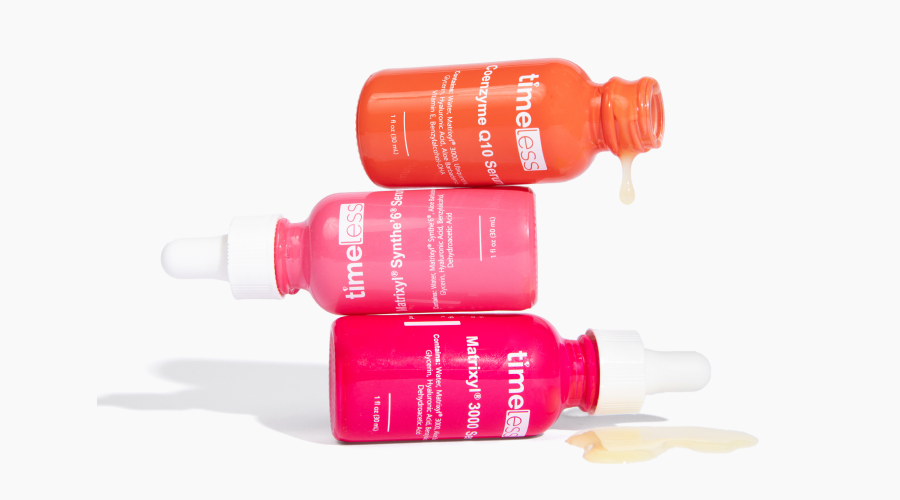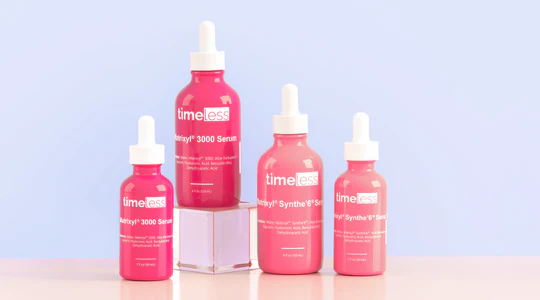Peptides are another beauty buzzword, so what’s all the hype about? For those of us wary of cosmetic procedures or just not willing (or able!) to spend that kind of money on our skin, it appears that peptides have a lot to offer when it comes to that coveted trifecta – lifting, firming and smoothing fine lines and wrinkles.
Peptides are showing up in serums, moisturizers and even masks, and for those who are going to the spa, it turns out they’re helpful in the skin’s recovery after treatments, such as micro-needling or light laser therapy.
So how do they work?
Skin is made up mostly of one particular protein- collagen. Collagen is a whole protein, while peptides are fragments of proteins that can work as tiny messengers, absorbing into the skin and telling those cells to make more collagen!
Matrixyl is an example of this tiny messenger, known as a signaling peptide. Other kinds of peptides include carrier peptides, neurotransmitter inhibitors and enzyme modulating peptides.
As we age, and our skin cells essentially start breaking down, two of the most popular and effective peptide products are Timeless’ Matrixyl 3000™ and Matrixyl® Synthe'6 serums.
In a nutshell, both Matrixyl’s work to:
- Minimize wrinkles and fine lines
- Increase firmness
- Decrease sagging
- Improve moisture retention
We call it the “Builder” Matrixyl 3000™ is the combination of two peptides – palmitoyl oligopeptide and palmitoyl tetrapeptide-7 that address wrinkles and collagen loss, but also stimulate the skin’s repair mechanism.
Your 20s is a great time to start using Matrixyl 3000™ for maintenance and prevention of wrinkles and fine lines, as well as helping combat the breakdown of skin from extrinsic factors, such as sun damage and pollution.
We call it the “Restorer”, this highly concentrated serum works on six essential components of the skin’s structure, Collagen I, II, IV, Fibronectin, Hyaluronic Acid, and Lamin 5, working on the deeper layers to heal and regenerate. It helps the skin’s ability to be more resilient.
As we progress through our 30s and beyond, Matrixyl® Synthe'6® can address more pronounced wrinkles, the accelerated aging caused by sun damage and pollution, as well as help with water retention and problem age-areas such as the decollete and neck.
How to Use Matrixyl Serums
- Matrixyl serums are great as an evening serum when your skin is in restorative mode.
- It’s best not to mix these peptides with other highly acidic or exfoliating ingredients such as a prescription cream, AHA or BHA products.
- We don’t recommend layering both Matrixyl serums together, but rather using them independently or alternating one in the morning and one at night, or every other day.
Try:
AM/PM - On a clean face, apply 2-3 drops of Matrixyl S6 OR Matrixyl 3000 serum using fingertips to evenly spread product and finishing with a patting motion to “push” into skin. Next, apply Hyaluronic Acid Serum with Vitamin C followed with a thin layer of Coenzyme Q10 serum. Finish with appropriate Pure Oil and moisturizer (SPF for the day).
Throughout the day, you can spritz with HA Matrixyl 3000™ spray to refresh the face or add some extra hydration!
PM – On a clean face, apply Matrixyl S6 OR Matrixyl 3000 serum (alternate every other night) followed with a thin layer of CoEnzyme Q10 serum. Finish with appropriate Pure Oil and moisturizer.
"DISCLAIMER: The information on our blogs has been compiled from published sources and the experience of the Timeless Skin Care team. The blogs are not intended to diagnose or treat a medical condition or to address every skin type or condition. While reasonable effort is made to publish reliable and up to date information, Timeless Skin Care cannot predict how a skin care regimen will affect every individual user. Timeless does not guarantee any specific outcomes or the accuracy of all information presented and accepts no liability in respect of any omission or error. If you are uncertain about possible sensitivity when using Timeless Skin Care products, please do a patch test before use. If you have any skin concerns, please talk to your physician or consult a dermatologist."












